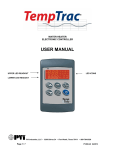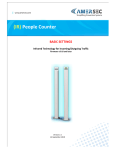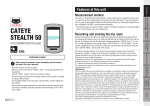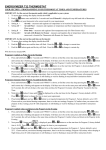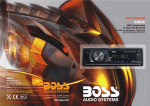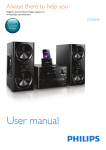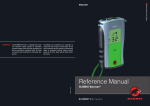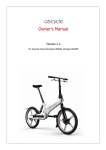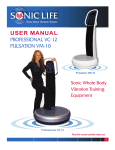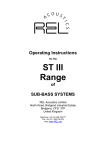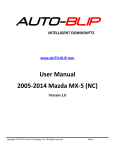Download see manual for more times
Transcript
Be Seen... Ride Safe! Turn-ON Procedure Two terms that you need to understand: When it comes to the power button, you can either CLICK it or PRESS it. The only difference between the two is the time that the button is held down. The first thing that you’ll notice is that if you simply connect power and click the button… nothing will happen. Don’t worry! This is because of the safety turn-on feature called “Superlock.” I ship the lights with Superlock enabled, but you can disable it, as long as you’re OK with the possibility of a single click turning the light on (procedure available on web site). The light can be turned on into 2 different modes: STEADY mode and FLASH mode, but take note that you must START with the LIGHT OFF to enter either of these modes. There is no method for switching between STEADY mode and FLASH mode without first turning the light OFF. So with Superlock enabled (shipping default), the two turn-on possibilities are as follows: In practice, when performing the turn-on into flash mode sequence, it’s best just to “hold down” the button on that last PRESS until you see flashing begin. Note also that with Superlock disabled, you would simply remove the first 2 clicks from both sequences. Turn-OFF Procedure To turn off, simply press-and-hold until the light turns off. The behavior will be slightly different depending on which mode you were in (steady or flashing). If in steady mode, the light cycles down to the lowest power level, then you’ll see a flash (indicating that you’ve reached L1), followed by a 2-second safety delay and power down. If in flashing mode, you just simply keep holding the button (you may see some odd flashing) until the light turns off. This will take between 2 and 3 seconds. Steady Mode Options Taillight Within steady mode for the taillight, you have 5 discrete power level steps. These may be referred to throughout the manual as Level 1 (L1), Level 2 (L2), etc. To move UP by one power level you CLICK, and to move down by one power level you PRESS. Once you’re at L1, a subsequent PRESS will cause the light to flash, alerting you to the fact that you’ve reached the lowest power level. Similarly, once at L5, a CLICK will cause the light to flash, indicating you’re already at L5. You may notice that the jump in the light level between L1 and L2 is fairly strong. This is because L1 is designated as “limp home” mode, drawing only a minimal amount of current for the longest possible run times. L1 is also a very good option for nighttime taillight use. Headlight The steady mode operation for the headlight varies slightly from the taillight and has been optimized for easy dimming for oncoming vehicles/riders. The light has been configured to use power levels 2, 3, and 5 in a low/medium/high arrangement. The diagram to the right shows the complete sequence of operating events for the headlight in steady mode. In practice, for nighttime use, you’ll simply be clicking back and forth between L3 and L5 as necessary. “Lightening Flash” mode #4 (see next page) is also a very good nighttime headlight option. TIP: Although the diagram shows the turnon process entering L2, it will actually turn on at the last used power level. For general road use with traffic, or anytime there are oncoming vehicles at night, you should use L3 or lower as the primary headlight power level to avoid blinding oncoming drivers. 1 DS User’s Manual: Build 4 and Up Be Seen... Ride Safe! Flash Mode Options Although the new version of the firmware for these lights will allow any of the 6 flash pattern “placeholders” to be completely customized (refer to the most recent DSFlex Manual for details), the “factory default” patterns have been customized for DesignShine and are shown below. Flash modes operate identically between the headlight and taillight; however, there a couple of patterns that were developed specifically for either the head or tail. The first three (in yellow) should be reserved for daytime only where as the last three (grey) are generally appropriate for night. DesignShine (Build 4 and up) Flash Patterns Mode # Quick Name 1 L5 ON/OFF 2 L5 EMS Description flash with 400ms delay between bursts. 3 L3 ON/OFF 4 L3/L5 Lightening Strike Best Application Simple on/off flash, roughly 3 per second, at Daytime ONLY, either light. Best for solo riding. the highest power level. Slightly longer run times than EMS mode. Modeled after "Emergency Medical Service" When you need the highest level of recognition, this is it. Absolutely daytime ONLY. lights. High intensity rapid (11Hz) 4-burst ***EXTREMELY*** dangerous at night. Simple on/off flash, roughly 3 per second, at Daytime ONLY, either light. A little more "polite" level 3. for group riding, or for daytime battery conservation. Designed for the headlight, for nighttime. Short L5 burst gives a nice "eye catching" flash, but not long Solid level 3 operation with 40ms burst to level 5. You'll find yourself wondering… was enough to be blinding. Very ridable at night since it's not overly "stroby." NOT RECOMMEND FOR that lightening? TAILLIGHT USE AT NIGHT. 5 L1/L2 Triple Pulse Solid level 1 operation with 120ms Triple pulse to level 3. 6 L1/L2 Toggle Evenly spaced 500ms duration toggling between level 1 and level 2. Designed for the taillight, for nightime. The triple pulse is very effective from dusk to dark at catching attention in peripheral vision, but not too intense when looked at directly. Nice simple, but bold pattern for nighttime taillight. Use this if you find yourself running low on battery and you need to extend your run time, or even better, switch to L1 steady. While in Flash Mode, switching from one mode to the next is a cyclical operation simply requiring a CLICK between modes (see right). You may notice about 1 second of delay when switching between modes 3 and 4 where the light remains off. This is completely normal. You may also notice on occasion that the light will ignore your CLICK request to switch modes. This is likely just a small timing issue and totally normal. Note, when you’re in flash mode and pressand-hold to turn the light off, it will remember the particular mode number and come on in that mode the next time you power up in flash mode. Determining Battery Status The head and taillights use the exact same battery monitoring circuitry and logic. However, there are multiple methods with which you can determine the approximate charge level of the battery. The first method is with an LED mounted internally on the circuit board which will be visible through the small oval “viewing window” in the case lid, immediately next to the power button (you may need to shade slightly to view in bright sun). This method will always be active. Method number two is referred to as “out-the-front/back” indication. In this case, the main LEDs will be used to “tap out” a simple message (similar to Morse code) from which you can determine the battery status. Note that when either light is first turned on, you should see a short flash of the on-board LED to indicate the health of the controller. By default, the headlight comes with the “out-the-front” indication disabled and the taillight has the “out-the-back” indication enabled. However, just like with every other aspect of the controller, these settings can be changed to suite your preference. And speaking of making changes to the controller, there are two good resources to help you get started with this. First you th should visit the DesignShine Forums site and read the 5 entry to the “All things Batteries” thread. Here you will find a direct link to download the Reprogramming Instructions PDF file. http://www.designshinelighting.com/showthread.php?96 Secondly, you can always find THIS manual and the full up user’s manual for the controller board at: https://sites.google.com/site/designshinelighting/user-manuals This hard copy will get you started but please go to the USER MANUALS site and read the full document to understand the battery warning system, along with mounting and safety issues. 2 DS User’s Manual: Build 4 and Up Be Seen... Ride Safe! The following table is intended to show you the behavior of the lights’ battery status indication system for every possible combination of operation mode and approximate battery discharge level. Although I’ve programmed the lights with reasonably good VOLTAGE detection levels for the 50% and 20% discharge levels, there will be some variation (perhaps significant) from one battery manufacturer to the next and between fresh vs. old batteries. This is where the “FLEX” in the DSFlex controller can be very handy. If you find after running your light through a few discharge cycles that you’d like to have a little more or less warning time for either the 50% or 20% levels, then the voltage thresholds can be easily be changed. Note that even a change of 0.1V in the threshold levels can make a big difference in the warning times, so I recommend making no more than a 0.1V change at a time. I also recommend NOT changing the default cutoff threshold value. Full instructions for how to adjust the warning times can be found again at: http://www.designshinelighting.com/showthread.php?96 Battery Level Internal Status LED (always active) Any Mode Optional Out-the-Front/Back Main LED Indication (Tail-enabled by default: Head-disabled) Steady Mode Flash Mode Power ON One short status LED blip to indicate controller heath. 100% to 50% No Status LED Illumination Normal Operation Normal Operation Flash pattern suspended momentarily 1 short OFF blip, with 20 with steady burn at the current high seconds between blips. This 50% to 20% Solid ON power level for 3 seconds, with a single warning cycle will continue until pulse to the current low level after 1.5 discharge reaches 20%. seconds. 2 short OFF blips, every 20 Same as above only with a double 20% to 1 min Flashing (1 pulse per sec) seconds until 1 minute warning. pulse. Flashing (double pulse per 3 short OFF blips, every 20 1min warning Same as above only with a triple pulse. sec) until cutoff. seconds until cutoff. Main LED will pulse 10 times Main LED will pulse 10 times Main LED will pulse 10 times then shut OFF then shut down. then shut down. down. To gain a full understanding of the battery status reporting, take a look at the battery discharge curve below. This was taken with a DS-500 taillight running at steady L5 with a Magicshine MJ-6038, 4400mAH battery. The shape of this curve is typical for lithium-ion with the steepest rolloff occurring at the full discharge levels. Note that the Medium, Low, and Cut-off threshold voltage levels are all adjustable as needed. The values shown here are the default values loaded into the Build#4 and later firmware. Although subtle, there will always be some voltage loss in the cable between the battery and light. Higher current and longer cables will increase this effect. Practically, this means that when running at much lower power levels with lower current, the points on the horizontal time axis (red dotted lines) will move slightly to the right (on a percentage basis). With the headlight on L5 drawing more current, they will move slightly to the left (again on a percentage basis). This plot is intended primarily to instruct you on the status indication system, but it also illustrates the somewhat inexact science of determining run times. It should also be noted that even after the light has shut off automatically, you will normally be able to turn it on several more times, for 1-minute intervals, as a last ditch method for getting “out of the woods” until the battery itself hits its internal protection limit. This option should NOT be used with any unprotected battery packs. 3 DS User’s Manual: Build 4 and Up Be Seen... Ride Safe! Run Times Now that you’ve seen some of the “Logic” behind the battery status indication system, let’s take a look at how to determine overall run times. Run times are primarily dependent to two factors: total power consumption and battery capacity. To a lesser degree, run times can be dependent on temperature. In general, if the battery and light are running in sub-freezing temps, run times are going to be lower by some percentage margin. Your mileage may vary on this one. For the purposes of these run time calculations, there is an assumption of room temperature. Please note that these numbers represent good engineering estimates, but there may be some need to tweak up or down depending on a particular battery pack and/or the relative age of the pack. The tables below combine empirical test data with the known electrical characteristics of the light to arrive at a best estimate for the run times at the various power levels and flash modes. Flash mode 4 is a “special condition” for the taillight. Although borderline acceptable for nighttime use, the “out-the-back” battery indication system will momentarily set the light to steady level 5 for 3-seconds at 20-second intervals during the medium and low battery periods. Since the “out-the-back” indication is enabled by default for the taillight, this could result in an un-intentional and dangerous blasting of level 5 at night. DS-500 Taillight Run Times (Hours) 7.4V Pack (mAH) 7.4V Pack (mAH) Power Level Lumens 4400 5600 Steady Flashing Steady Flashing 1 111 110.0 140.0 2 239 17.9 22.8 3 378 11.1 14.2 *4 521 7.0 8.8 *5 798 3.5 4.5 Flash mode 1 Level 5 on/off 11.7 14.9 Flash mode 2 Level 5 EMS on/off 10.9 13.9 Flash mode 3 Level 3 on/off 37.3 47.5 Flash mode 4 Level 3/5 Lightening 10.9 13.9 Flash mode 5 Level 1/2 triple pulse 83.7 106.5 Flash mode 6 Level 1/2 toggle 63.9 81.4 Color Legend Good nightime use Daytime ONLY, dangerous at night *Daytime ONLY, good airflow required for continuous use. Other Batteries For batteries of different capacities, multiply run-time values results at 4400mAH by the ratio: (desired pack capacity in maH/4400) A similar headlight runtime analysis was performed and the results are shown below. Take note of the recommended times of day for the given power levels and flash modes. Ultimately, you need to use good judgment when you set the light so that you’re not at risk of blinding or dis-orienting the drivers around you. During dusk/dawn and nighttime hours, you should avoid levels 4 and 5 completely and in general, in low-light settings, flash modes 4 through 6 are preferable since they all use a pulse/ON technique to avoid the dis-orienting effect of on/off flashing at night. The steady power cycle operation of the headlight (page 1) is setup specifically to allow easy “dimming” for on-coming traffic with a single click if you find that you prefer riding at night on level 5. DS-1300 Headlight Run Times (Hours) Color Legend 7.4V Pack (mAH) 7.4V Pack (mAH) Good nightime use Power Level Lumens 4400 5600 (rec) Daytime ONLY, dangerous at night Steady Flashing Steady Flashing *Day or Night use, but avoid with on1 113 44.0 56.0 coming traffic. Good air-flow is required 2 412 9.2 11.7 for continuous use. 3 655 6.2 7.9 *4 908 4.0 5.0 Other Batteries *5 1402 2.0 2.5 For batteries of different capacities, Flash mode 1 Level 5 on/off 6.7 8.5 multiply run-time values results at Flash mode 2 Level 5 EMS on/off 6.2 7.9 4400mAH by the ratio: Flash mode 3 Level 3 on/off 20.8 26.5 (desired pack capacity in maH/4400) Flash mode 4 Level 3/5 Lightening 6.1 7.7 Flash mode 5 Level 1/2 triple pulse 34.0 43.3 Flash mode 6 Level 1/2 toggle 26.6 33.8 NOTE: Maximum headlight output will be limited to Level 4 in any mode during the LOW battery warning period. 4 DS User’s Manual: Build 4 and Up Be Seen... Ride Safe! Mounting Options Mounting of the lights is very straight forward, but it’s important to always make sure that your mount is secure and that the attach point is strong enough to handle the repetitive shock loads due to the mounted weight of the light. Each light with the extension bar weighs in at roughly 120 grams. Specifications of the mounting hardware are shown below. #6-32, 5/64" Nylon patch locking holddown screw. Cateye H-27 “spacer” aka quick-release (headlight only) Alternate mounting holes for offset options. #8-32, 5/64" Set screw for locking position of light. DS Extender Bar Mounting System From the diagram above, you can see that there are two screws that are used to hold the light firmly to the extension bar. Without exception, when setting the angle of the light, you should adhere to the following sequence: 1. Check that the set screw is unscrewed slightly and NOT contacting the housing. 2. Using the provided 5/64” Allan wrench, set the angle of the light and fully tighten the hold-down screw if there is not already some friction. 3. Lock the angle by lightly tightening the set screw. Do NOT over tighten. Only a small amount of tightening is required. 4. When removing the screws, just the opposite is required. If you try to loosen the hold-down screw before loosening the set-screw, you may find that it’s almost impossible, and you may damage the head of the screw. The hold-down screw has a “nylon patch” on the threads, which makes it grab tightly by design. If the screw is removed and re-inserted multiple times, the locking nylon function will eventually diminish. This is OK. In practice, once the set-screw is tightened, the extension bar acts like a spring and puts binding forces on both screws to prevent any accidental loosening. Although the H-27 spacer can be removed, I recommend leaving it on the extender bar. If helmet mounting is desired without the extender bar, a separate H-27 spacer should be obtained that can be mounted directly to the light body in place of the extender bar. (Note that the small Philips screw, not shown, on the opposite side of the bar acts as an anti-rotation pin for the H-27 and is actually threaded into the aluminum bar. This screw should never be over tightened in order to avoid stripping these threads. 5 DS User’s Manual: Build 4 and Up Be Seen... Ride Safe! The basic mounting philosophy for the lights is to permanently attach the appropriate clamp(s) to the bikes that will be using the lights. This way, you can easily swap the lights between bikes without having to reset the aiming angles. The quick-release also facilitates easy removal for commuters. There are two basic clamps as shown to the right. Both clamps incorporate several degrees of “left/right” aiming capability. Because the taillight will often be mounted on a vertically oriented tube, you should, in this case, relieve the clamp of its free movement by rotating the clamp base into its most “downward” position before setting the angle of the light body. In other words, after you mount the light, you should push down on the light body until the clamp movement stops. Re-adjust the angle of the light body with the set screw at this point if necessary in order to achieve the optimal aiming angle. When aiming the lights, I’ve found that straight back (parallel) to the ground is optimum for the taillight, and the headlight should be angled down very slightly so that the front “edge” of the spot beam is around 15-16’ feet in front of the wheel. There is definitely an optimum aiming angle for the headlight, which may take a bit of experimentation to find. Thankfully, once the angle of the camp is set properly it will never move accidentally during vibration. H32 “standard” clamp (10mm up to 28mm) H31 “oversize” clamp (28 to 32 mm) In practice, I’ve found that the H32 works fine on 27.2mm seat posts by removing both of the thin spacer pieces. For seat-stay applications, (similar to below) you may need to use some combination of the original spacers along with the additional included thick spring rubber spacer. The figures below also show the recommend orientation of the H32 clamp on the left seat stay. Pay particular attention to the preferred orientation of the camlock handle. In general, after your first few rides with the light, just double check to insure that your mounts are staying exactly where you set them, and if not, you may need to put another turn on the cam lock handle. You MUST find the right combination of spacer material such that the camlock screw does not protrude too high into the light mounting area as illustrated below (Left). Max Height OK Camlock lever forward. OK but not ideal. Camlock lever to the left is best. Too high, will damage spacer Mounting Clamp Considerations For the headlight, either the H32 or H31 may be used, depending on the diameter of the bars at the mount point. It’s recommended to mount as close to the stem as possible. In fact, with the current design, you may choose to use one of the “offset” mounting holes on the underside of the mount (see previous page) to move the light body closer to centerline of the stem. Note that either light can be mounted to EITHER side of the extension bar as required by your particular application. Simply 1) remove the hold-down screw, 2) remove and re-install the set-screw from the other side of the extender bar, then 3) re-attach the light to the opposite side of the bar. This allows for even more flexibility in various mounting situations. 6 DS User’s Manual: Build 4 and Up Be Seen... Ride Safe! Additional Instructions for H31 Mount (Vibration Damping) Due to a very subtle change in the mold between the H32 (which is very solid) and the H31, there is a small amount of undesirable vertical rocking movement possible with the headlight on the extension bar (not an issue with taillight use). If this becomes a problem while riding (even with the H32), a small piece of rubber tubing (standard vacuum line hose) can be wedged into the hole of the H31 clamp to form a “damper” and effectively mitigate this issue. Other similar materials could be used. If you received an H31 clamp for use with a headlight, a small rubber tube has already been put in place to illustrate how it should be used (see below). You want to push the rubber tube as far down on the threaded stud as possible and still have at least ¼” sticking up. H31 Mount with Optional Vibration Damping Tube Installed Horizontal vs. Vertical Taillight Operation Although the light will ship setup for vertical operation, the new removable lens cover will allow you to reorient the elliptical lens for optimum performance from either mounting orientation. If you have a need for both orientations with the same light, it is highly recommended that you pick the orientation that will be used MOST often, rather than continually removing the lens cover and swapping lenses. When viewing the elliptical lens from the rear of the bike, the proper orientation is for the “ridges” of the lens to run vertically. Colored Filter Use and Lens Cover Removal The colored headlight filters were designed with daytime use in mind and can be installed simply by removing the center screw and adding the filter to the front face of the light. Tighten to the same tightness as without the filter. The lens cover should stay on, and does not need to be removed when adding or removing the color filter. If swapping or replacing LED lenses becomes necessary for any reason, you should follow the general procedure outlined below to remove the lens cover. This should only be done in a clean, relatively dust-free environment. You want to avoid touching the domes of the LEDs as well as being careful not to get silicon grease on the lenses themselves. Lens Cover Removal Process 7 DS User’s Manual: Build 4 and Up Be Seen... Ride Safe! The cover is able to be removed and re-installed many times without the need for additional silicon grease. But if it becomes obvious that a good seal is not being made between the lens cover and o-ring, the silicon grease can be obtained very inexpensively in the plumbing section of Home Depot or similar stores. A small hobby paint brush would then be used to LIGHTLY brush a coat of grease around the sealing surface of the clear lens cover. Although unlikely, but if sealing ever becomes a problem for the small “white” o-rings that seal against the lenses themselves, then a VERY light film of this grease could also be used at that junction. I would recommend cutting off the head of Q-tip and just using the edge of the paper stick with an extremely small amount of grease to perform this operation if ever necessary. Battery Mounting All build #4 and up lights will be configured for 7.4V li-ion pack use in order to take advantage of the many off-the-shelf options that are available for powering these lights. When it comes time to replace the battery, a good source compatible batteries is “Action-LED-lights.com.” In general, any 7.4V battery with the “Magicshine” style 2.1mm power connector will work just fine. When you received your light, you may have also received a spare wired power connector. This is for your “future” use, if you ever find that you need to adapt a “generic” battery to the proper power connector. In most cases for stand-alone taillight or single-battery, dual light use, battery mounting will consist of stowing the battery in a saddle bag. However, in the for solo headlight use, many batteries use a Velcro or otherwise strap system to secure the battery to the underside of the stem or a section of tubing as shown below. When mounting the battery under the stem, be sure to prevent any binding or rubbing of the battery on any portion of the non-rotating steerer tube. When using a strap, it’s important to get as much cinching force on the battery as possible for a secure mount. In general, you will want to position the “D” ring of the strap on the TOP of the tube so that you can very tightly cinch the strap by pulling down before making the Velcro connection. If your strap has a slight bit of “stretch” to it, you should pull it tightly enough to begin to feel this slight stretch before you cinch it down. Typical Stand-Alone Headlight Battery Mounting Locations Battery Charging and Maintenence Lithium-ion battery charging and care are relatively simple and require that only a few good habits be established for maximum life, regardless of the brand of the battery. 1. Always charge the battery in a room-temperature environment. Be especially cautious to NEVER charge the battery below freezing. 2. Plug in the charger first (green light will come on), then plug in the battery. If the battery is depleted low enough, the light will turn red and stay red until charging is complete. If the battery is nearly full, then the light may remain green when the battery is plugged in. 3. Remove the battery from the charger as soon as reasonably possible after the charge cycle is complete. 4. If you plan to store the battery unused for more than a month, it is recommended to first drain the battery to HALF CHARGE. Storing a battery with a full charge will quickly diminish its capacity. Li-ion cells in general have a “life span” independent of the number of charge cycles. So even if the pack is not used, its life expectancy is still only 2 to 3 years, which is typical for the li-ion chemistry. 5. Charging an empty 4400maH pack will take anywhere from 5 to 7 hours with a low-cost automatic 1-amp charger. More or less time will be required for higher or lower capacity packs, respectively. 8 DS User’s Manual: Build 4 and Up Safety Precautions and Warranty Heating These lights have very robust heat management characteristics, designed to prevent any damage to YOU or to the LEDs and electronics. But still, you should exercise extreme care when operating the light in a no air-flow environment. Definitely KEEP OUT OF REACH OF CHILDREN. To increase your own understanding of the limits of operation, try this experiment. With the lights indoors and sitting on a hard surface (or mounted on the bicycle), turn the lightt on steady at level 5 (high). Watch and periodically feel the light until you see the light level automatically drop down to a lower level (somewhere between 4 and 6 minutes later). At this point, carefully and momentarily touch the case of the light at various places. It will be very hot, in fact slightly painful if you were to hold it for an extended amount of time, but not quite hot enough to burn you. Make a mental note of how this feels. This should be the hottest that the headlight ever gets, and the temperature trip point has been chosen to provide the optimum usability level on the bike, so that momentary stops on the bike do not have time to trip the thermal protection circuit. In fact, even a mild breeze will generally allow sustained Level 5 operation. Colored Lenses The colored lens covers should be handled carefully, and do avoid wiping it if dry to avoid scratching. Unlike the clear lens cover (which is made from high temperature polycarbonate), the colored lenses are Acrylic and not as tolerant to high temperatures. As such, it is recommended that you only use the colored lenses in flashing modes and preferably only outdoors to avoid any excess heat damage to the clarity of the filter. This is very unlikely, but worth mentioning. As you know, these lights are EXTREMELY powerful, so here goes with the “official” disclaimers (please do take the time to read them all or my wife is going to make me call a lawyer ;) Most of these fall into the “common sense” category, but I had to state them. See website for full disclaimer. 1. Never, under any circumstances look directly at the lights from close range (while in your hand) or point the lights directly at anyone’s eyes at close range. 2. Never shine the light directly on your skin from close range (1/8” inch or less) It CAN burn you if you leave it there too long. 3. Never use level 4 or 5 on the taillight at night, and it is highly recommended that you run the taillight in steady mode at night (or appropriate flash mode). When using level 5 on the headlight at night, please be comfortable enough with the operation of the light to be able to dim quickly to level 3 or lower for oncoming cars. 4. Never turn the lights on and leave un-attended. If the heat sink fins were partially blocked, overheating and damage is a possibility with long periods of operation with no airflow. 5. Never turn the lights on and leave in contact with flammable materials. 6. If at any time you find the light has become too hot to touch and/or to press and hold the button to turn-off, simply disconnect the battery wire (normally this should not happen). 7. NEVER under any circumstance leave the battery pack in an un-attended car that is going to be left in the sun for any length of time. In other words, do not expose the battery to excessive heat. All charging and storage environments should be near room temperature for best performance. 8. DO take care not to drop the battery onto hard surfaces. They contain an immense amount of energy in a very small package. At any sign of trauma or damage to the battery, you should immediately discontinue use, dispose of safely, and replace with a new pack. Warranty These lights are tough… really tough, and should provide you with years of trouble free service due to the extreme level of over-engineering. If anything breaks in the first year, just send it back for repair. All you need to do is pay the postage to ship it to me. Accidents do happen though, so even if you do manage to damage the plastic bits, or the power cable several years down the road, I can replace these things for you a minimal cost. Just email me first at: [email protected]. All mail correspondence should go to 137 Holbrook Drive, Huntsville AL, 35806. Since I’m only a “pass-through” battery provider, I can only help with battery issues to the extent that they are covered by the original supplier. 9 DS User’s Manual: Build 4 and Up









